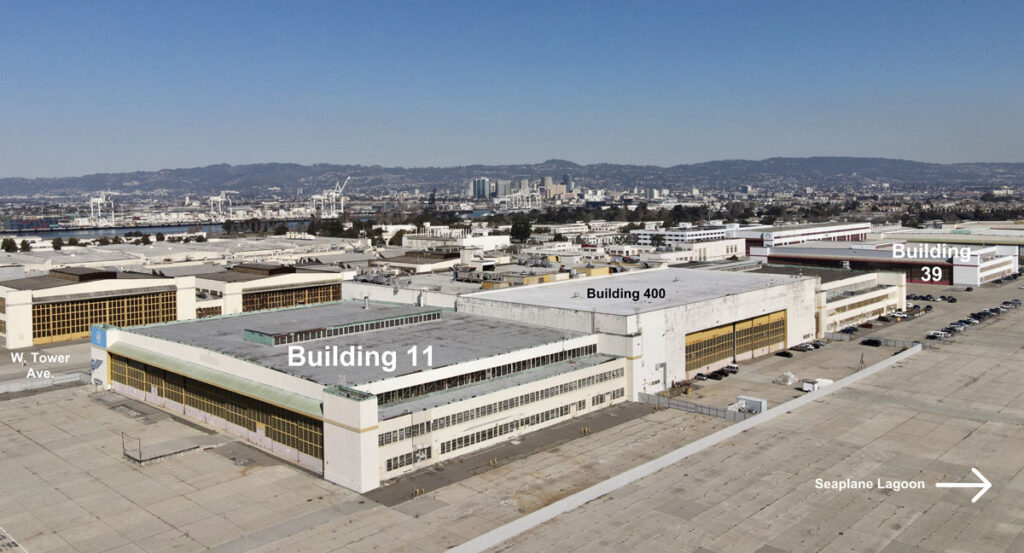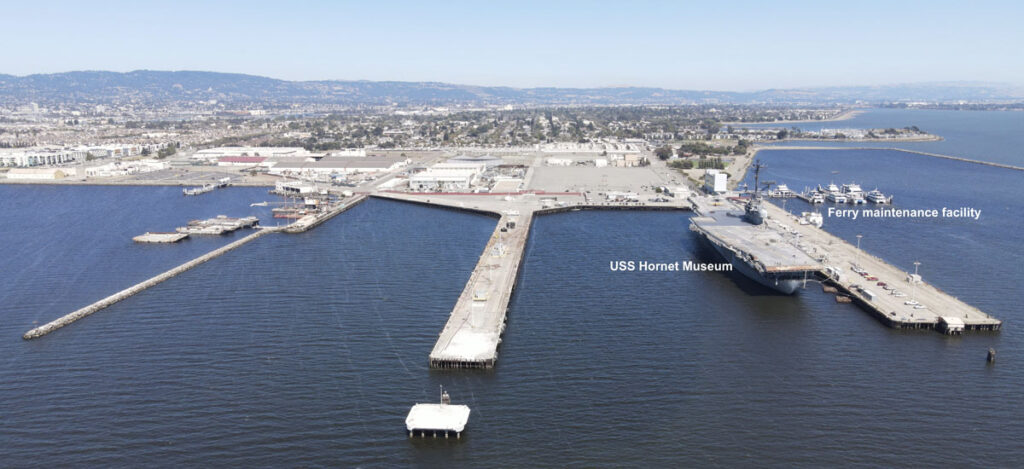City Council will meet in closed session on April 18 to negotiate four property leases at Alameda Point. Two are buildings and two are at a pier. It is unknown if either of the two proposed building leases will include the option to purchase. Nor is it known if the Council has weighed selling rather than leasing the two buildings and how it fits in with the goal of replacing antiquated infrastructure.

Photo Richard Bangert.
Hangar 39: manufacturer of drone pesticide sprayers negotiating lease terms
City staff and the Council will be negotiating a lease with an Oakland company called Pyka, which makes drone airplanes designed for spraying pesticides on agricultural crops in Costa Rica and elsewhere. Their pesticide-spraying aircraft is called “Pelican Spray.” The pilotless plane was recently approved by the Costa Rican government for flying in that country to spray large commercial banana plantations, both day and night.
“Americans, who buy bananas more than any other fruit, may not realize that most of their bananas are grown in places like Costa Rica, where rampant pesticide use leads to sickness,” Madison Stewart wrote in “The Deadly Side of America’s Banana Obsession,” published by the Pulitzer Center on March 30, 2020.
The benefits claimed by the manufacturer include non-fossil-fuel propulsion of the aircraft and reduced risk of unintended chemical drift because winds are calmer at night. Pyka calls aerial pesticide spraying “crop protection missions.” But scientists concerned about human and environmental health question whether the benefits outweigh the negatives of aerial pesticide spraying.

“[A]griculture and especially the use of pesticides have been identified as a critical factor affecting biodiversity in this area,” according to a scientific study, “Pesticide use in banana plantations in Costa Rica,” published in the April 2023 issue of Environment International. “This biodiversity is threatened by land-use change resulting in habitat modification and fragmentation,” due to deforestation, the study states.
The study found that frequent and year-round application of pesticides at high rates result in high environmental pesticide concentrations within conventional banana plantations and in adjacent ecosystems, such as rainforest. Exposure to humans and the environment is especially high for fungicides as they are applied by aircraft and at high frequencies, according to the study.
The need for fungicides is due to a fungus called black leaf streak on banana leaves that interrupts photosynthesis and drastically reduces banana growth. “These pesticides can be an essential part of the production of a crop that is then sold in countries where, ironically, they are banned,” the 2023 pesticide study states.
To fight the fungus, the banana industry pesticides typically include Mancozeb. “Mancozeb, the central molecule in the current fungicide program, was identified as an endocrine disruptor affecting reproduction, which resulted in a ban in Europe in 2021,” according to the pesticide study.
In another study, published by the National Library of Medicine’s National Center for Biotechnology Information in 2016, the neurological development of children in Costa Rica living near banana plantations was evaluated. The study concluded that pesticide exposure was associated with impaired cognitive skills in children aged 6 to 9 years.
And it’s not just people that are affected. Wildlife such as fish and amphibians are also harmed. The 2023 pesticide study provides examples of how “the permanent presence of pesticides from banana plantations can affect the physiology and behavior of fish.” It does so by impacting body chemistry. “Especially fungicides, which are applied weekly in conventional banana plantations, proved to be acutely toxic for temperate amphibians,” the pesticide study found.
The Audubon Society sounded alarm bells about this situation almost 10 years ago. “Pesticides used in banana farming are leaching into streams and canals downstream, and showing up in the bloodstreams of Costa Rica’s crocodile, the spectacled caiman,” Simone Scully wrote in “Banana Farming Harming Costa Rican Crocodile,” published in Audubon magazine in October 2013.

Photo Richard Bangert.
Hangar 11: medical device company eyeing lease
Next up on the April 18 city council agenda, City staff and the Council will be negotiating a lease with medical device maker Science to set up shop in a hangar (Building 11) at the end of West Tower Avenue, across the street from the Air Traffic Control Tower. The company specializes in creating novel medical devices that incorporate the latest microchip technology and gene therapy.
One such device is called Science Eye. It can be implanted inside the eye of patients suffering from macular degeneration. It places a genetically-modified protein nanoparticle on the optic nerve cells, making them light-sensitive at a specific wavelength. Next, a tiny, flexible high-resolution display film is surgically inserted over the retina to allow fine control of the newly light-sensitive nerve cells, according to the company.
It is unknown whether the Science lease of Building 11 will require a purchase option in the near future. This is the same building that was offered for lease to Pyka last September. Around that same time, the City received an unsolicited offer to purchase the hangar for $24.9 million, as listed deep in the March 7 consultant report to the city council. That offer has not appeared on any City Council agenda for the Council to consider. By comparison, the currently underway multi-street infrastructure project is costing $31 million, which was funded by sales of five other buildings.

Piers: USS Hornet Museum getting ferry buddies
The last two leases deal with berthing spaces at a pier. One lease involves the Water Emergency Transportation Authority (WETA), also known as SF Bay Ferry, expanding its footprint at the pier next to the USS Hornet Museum. One possible reason for securing more berthing space: WETA’s long-term vision has the agency going from its current fleet of 16 ferries to as many as 87 ferries.
The other lease involves the USS Hornet Museum, a national historic military vessel. Almost all of the now-departed MARAD ready reserve ships went to dry dock for repainting in recent years, but no such luck for the museum.
The piers cannot be sold because they are located in state tidelands.
Contributing writer Richard Bangert posts stories and photos about environmental issues on his blog Alameda Point Environmental Report, https://alamedapointenviro.com. His writing is collected at AlamedaPost.com/Richard-Bangert.



